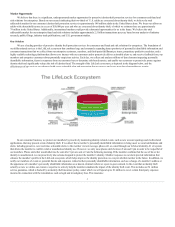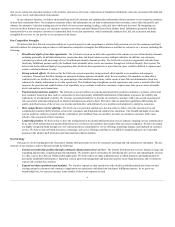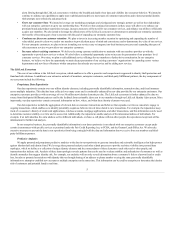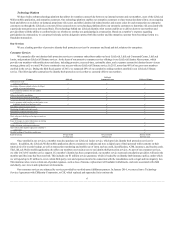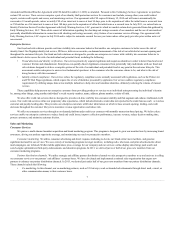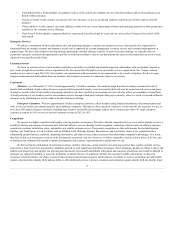LifeLock 2013 Annual Report Download - page 16
Download and view the complete annual report
Please find page 16 of the 2013 LifeLock annual report below. You can navigate through the pages in the report by either clicking on the pages listed below, or by using the keyword search tool below to find specific information within the annual report.
markets continues to develop. Our success in this area will be dependent on a wide range of factors, some of which are out of our control, including the
following:
•the efficacy of our marketing efforts;
•our ability to retain existing and obtain new customers and strategic partners;
•the quality and perceived value of our services;
•actions of our competitors, our strategic partners, and other third parties;
•positive or negative publicity, including material on the Internet;
•regulatory and other governmental related developments; and
•litigation related developments.
Sales and marketing expenses have historically been our largest operating expense, and we anticipate these expenses will continue to increase in the
foreseeable future as we continue to seek to grow our business and customer base and enhance our brand. These brand promotion activities may not yield
increased revenue and the efficacy of these activities will depend on a number of factors, including our ability to do the following:
•determine the appropriate creative message and media mix for advertising, marketing, and promotional expenditures;
•select the right markets, media, and specific media vehicles in which to advertise;
•identify the most effective and efficient level of spending in each market, media, and specific media vehicle; and
•effectively manage marketing costs, including creative and media expenses, in order to maintain acceptable customer acquisition costs.
Increases in the pricing of one or more of our marketing and advertising channels could increase our marketing and advertising expenses or cause us to
choose less expensive but possibly less effective marketing and advertising channels. If we implement new marketing and advertising strategies, we may
utilize marketing and advertising channels with significantly higher costs than ou r current channels, which in turn could adversely affect our operating
results. Implementing new marketing and advertising strategies also would increase the risk of devoting significant capital and other resources to endeavors
that do not prove to be cost effective. Further, we may over time become disproportionately reliant on one channel or strategic partner, which could limit our
marketing and advertising flexibility and increase our operating expenses. We also may incur marketing and advertising expenses significantly in advance of
the time we anticipate recognizing revenue associated with such expenses, and our marketing and advertising expenditures may not generate sufficient levels of
brand awareness or result in increased revenue. Even if our marketing and advertising expenses result in increased revenue, the increase might not offset our
related expenditures. If we are unable to maintain our marketing and advertising channels on cost-effective terms or replace or supplement existing marketing
and advertising channels with similarly or more effective channels, our marketing and advertising expenses could increase substantially, our customer base
could be adversely affected, and our business, operating results, financial condition, and reputation could suffer.
Furthermore, negative publicity, whether or not justified, relating to events or activities attributed to us, our employees, our strategic partners, our
affiliates, or others associated with any of these parties, may tarnish our reputation and reduce the value of our brands. Damage to our reputation and loss of
brand equity may reduce demand for our services and have an adverse effect on our business, operating results, and financial condition. Moreover, any
attempts to rebuild our reputation and restore the value of our brands may be costly and time consuming, and such efforts may not ultimately be successful.
We operate in a highly competitive business environment. Our primary competitors are the credit bureaus that include Experian, Equifax, and
TransUnion, as well as others, such as Affinion, Early Warning Systems, Intersections, and LexisNexis. Some of our competitors have substantially greater
financial, technical, marketing, distribution, and other resources than we possess that afford them competitive advantages. As a result, they may be able to
devote greater resources to the development, promotion, and sale of services, to deliver competitive services at lower prices or for free, and to introduce new
solutions and respond to market developments and customer requirements more quickly than we can. In addition, some of our competitors may have data that
we do not have or cannot obtain without difficulty. Any of these factors could reduce our growth, revenue, access to valuable data, or market share.
Our ability to compete successfully in our markets depends on a number of factors, both within and outside our control. Some of these factors include
the following:
•access to a breadth of identity and consumer transaction data;
•breadth and effectiveness of service offerings, including designing and introducing new services;
•brand recognition;
•technology;
13


